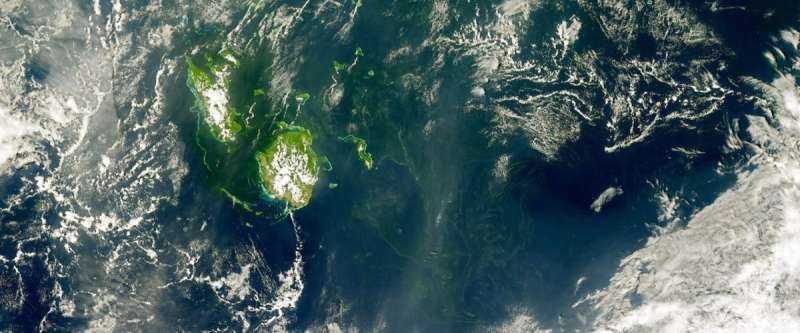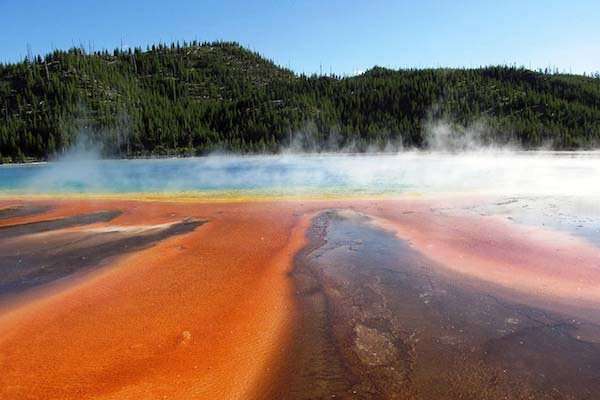How detecting light in the water affects how much food cyanobacteria get

The Montgomery lab has found a link between how water-dwelling bacteria, called cyanobacteria, monitor light quality in their surroundings and their capacity to do expand iconphotosynthesis well.
The basics of photosynthesis, how sunlight is captured and turned into usable energy that powers life on Earth, are well understood.
Now, scientists want to harness photosynthetic organisms, to syphon their energy yields into biofuels and industrial products. Doing so requires we grow the organisms in favorable environments with the right balance of food, light, and nutrients.
Yet, we don't know much about how an organism's territory impacts its photosynthetic performance—in other words, what would lead to good yields.
Cyanobacteria (cyanos, for short) are one of the organisms targeted for biotech applications. Although tiny – each 25 times smaller than the width of a human hair – they dominate the planet's oceans, lakes, and rivers.
Billions of years ago, they were one of the first organisms that started doing photosynthesis, the very reason there is life on Earth.
Today, cyanos are one of the planet's best photosynthetic performers, having developed countless systems to monitor light quality in their surroundings so they can fine-tune photosynthesis for optimal capacity.
The Science: light quality changes how cyanos get food
Brandon Rohnke, a grad student in the lab of Beronda Montgomery and the Department of Biochemistry & Molecular Biology, is part of a team that shows how a cyano, called Fremyella, tracks changes in available light wavelengths to control how much energy and food it gets out of photosynthesis. The study is published in the journal mSphere.

The 2 systems explained
- Tracking light wavelength quality: Cyanos sink or float in water to position themselves favorably in their environments, and the surrounding light wavelengths vary with depth. For example, on the surface, cyanos are exposed to rich amounts of red light. As they sink deeper, red light grows scarcer while green light remains abundant. Cyanos constantly track light quality and adjust themselves to capture the most available wavelength at any time. It is it like dialing your car radio to the exact frequencies to capture the waves coming from your favorite stations. But you can only tune to stations available at your location.
- Photosynthesis factories that produce food: In the last half of photosynthesis, carbon dioxide is taken from the air to produce energy molecules that power photosynthetic organisms. In cyanos, this step takes place inside tiny factories—call them nanofactories—officially known as carboxysomes.
In previous research, scientists genetically removed a major light detector (called RcaE) from the cyano, and it lost its ability to adapt to wavelength changes.
"To our surprise, the change impacted the nanofactories. Our lab cyano produced more nanofactories, but in smaller sizes," says Brandon. "In nature, the cyano cell will have 2 to 3 of them per cell cross-section. The mutant had up to 7."
Digging in, the team found that the absence of light detection led to:
- An increase in the materials that make up the external part of the nanofactory structure, its walls;
- A decrease in the machinery that goes inside the nanofactory and processes the cyano's food.
"What we think happened is that a larger number of structure material was competing to recruit a smaller number of available machines. The result was that the machinery was distributed among more numerous, but smaller nanofactories," Brandon says.
"Somehow, tracking external light is a way to tightly control nanofactory amount and structure. We are not yet sure how these two systems interact."
The team ruled out side-effects that could have caused this observation, such as the mutant's modified cell shape or the fact it produced large amounts of toxic byproducts.
The study is part of a push at the MSU-DOE Plant Research Laboratory to repurpose cyano nanofactories to make materials for human consumption, like renewable energy or medical products.
"Gaining the ability to dial up or down nanofactory number and size could help manage productivity levels in future biotech contexts," Brandon says. "But this is just one control mechanism. We have many more left to decipher."
It'll be a while yet before we power cars and planes with 'cyano fuel,' but scientists are slowly, but surely, revealing the way to get there.
More information: Brandon A. Rohnke et al. RcaE-Dependent Regulation of Carboxysome Structural Proteins Has a Central Role in Environmental Determination of Carboxysome Morphology and Abundance in Fremyella diplosiphon, mSphere (2018). DOI: 10.1128/mSphere.00617-17
Provided by Michigan State University




















